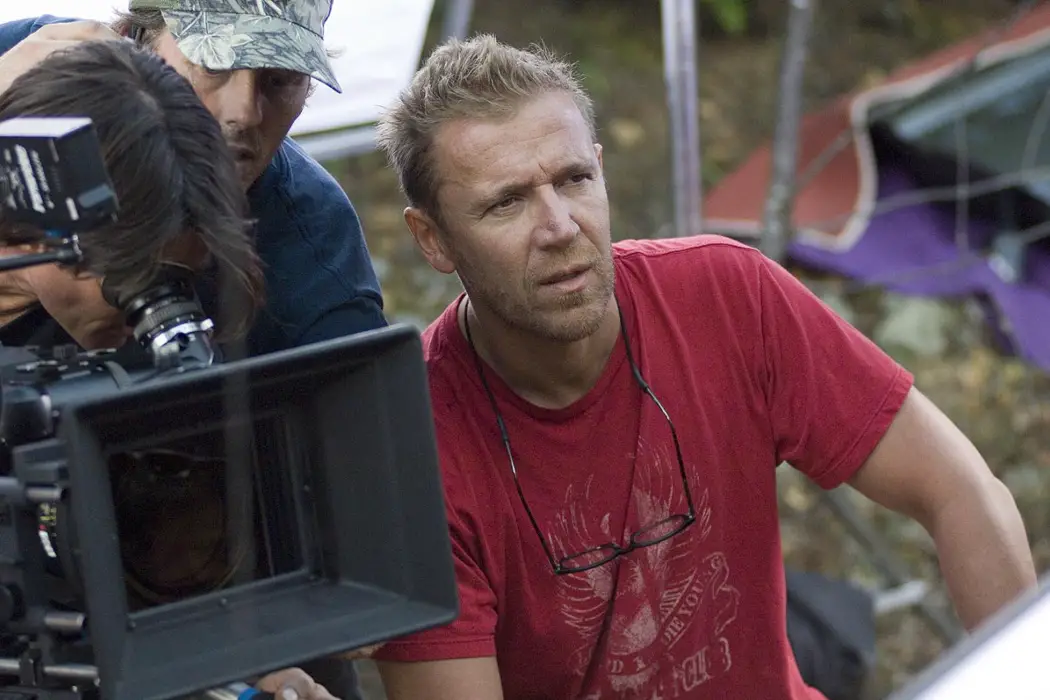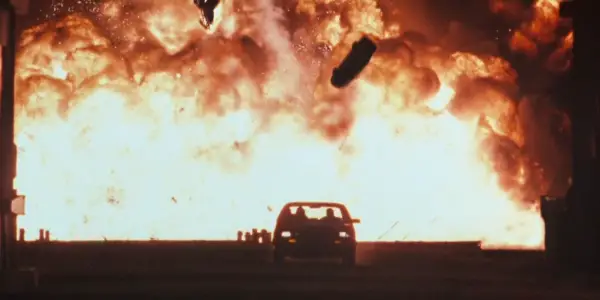In Praise Of Renny Harlin, Master Of Sturdy Trash

Freelance writer based in London. Pacino fanboy and trash connoisseur.
“I’d be pretentious if I said no way,” said Renny Harlin in a recent interview with The Guardian, when asked if he would direct a Marvel movie if the Disney megacorporation ever came calling, “but it’s known that in those movies, a lot of the sequences are digitally designed: it’s kind of an animated movie. And that takes away a lot of the fun that I have in movie-making.”
It might seem strange to some for the director of such films as A Nightmare on Elm Street 4: The Dream Master, Die Hard 2, and Deep Blue Sea — two franchise installments and a trashy creature feature notoriously replete with comically weightless CGI — to be lamenting the death of a particular kind of personal filmmaking process. Harlin isn’t exactly the virtuoso that Martin Scorsese is — he doesn’t have the same oeuvre of distinctive masterpieces to draw upon as emphatic evidence of the gaping chasm between movies as art and movies as content. Put on a Harlin film, and there isn’t anything that especially screams out as instantly identifiable — he’s no idiosyncratic auteur, leaving indelible stylistic fingerprints on every inch of celluloid he touches.
That’s not to say, however, that anybody could do what Harlin does and make a Renny Harlin movie — far from it. So often maligned as nothing more than a hack with an interminable list of flops to his name, Harlin might not be the saviour that cinema needs, but never, ever commit the crime of conflating him with — or more heinous still, comparing him unfavourably with — the enervated boardroom puppets that now sit lifelessly in the director’s chairs on Hollywood’s biggest sound stages. What Harlin has always had, from his beginnings as a director in his native Finland making his lean and mean debut Born American, all the way through his underrated Hollywood career, and even into his most recent period operating in the Chinese industry, is an acute and increasingly rare understanding of the intricate mechanics involved in sculpting a really solid action movie. He’s one of cinema’s great workhorses — a constantly dependable, and occasionally remarkable carpenter of sturdy entertainment.
Space and Form
What Harlin guarantees, on a foundational level, is spatial sophistication — the savviness to know exactly when to provide his audience with the clear and precise geographical information necessary to track the moving parts of an action sequence, but also exactly when to rob the audience of that clarity, to allow frisson to overwhelm coherence. Just look at his humble 2019 Chinese project Bodies at Rest, a super-compact cat-and-mouse thriller about three masked criminals trying to extract an incriminating bullet from a cadaver, and the two morticians, working alone on Christmas Eve, who have to stop them. The diligence with which Harlin maps out the deserted hospital as an environment loaded with possibilities, with setups and payoffs, is admirable, anchoring us firmly within the perspective of the unarmed, disadvantaged heroes, who have to exploit all of the building’s claustrophobic crannies and clinical contraptions in order to level the playing field against encroaching evil — mortuaries become fortresses, doorways become chokepoints, labs become minefields, corridors become avenues of anxiety. And then, as the film reaches its climax, Harlin suddenly pulls us into the criminals’ point of view, transforming the hospital into a labyrinth of glass and disembodied voices, eventually culminating in a tribute to the iconic finale of Orson Welles‘ The Lady from Shanghai, as a darkened computer room doubles as an illusory hall of mirrors primed to ensnare a bewildered gunman.

The tactility of Harlin‘s work, what he does with the forms within his precisely structured spaces, is what makes it so hard to imagine him operating within the suffocating parameters of a Marvel project, or indeed any modern tent-pole juggernaut. The soulless big studio mandate nowadays is to make everything as grim and devoid of texture as possible — to flatten and vitiate the popping palette of a comic book artist until the aesthetic resembles the inside of a cement mixer and not a single iota of artistry remains, before the marketing machine successfully sells the resulting slop as being inspired by auteurs and “about trauma, actually.” That’s what Harlin means when he talks about the joyless prospect of helming a Marvel movie — there’s nothing left of the tangible big-budget filmmaking that existed back in his prime during the 1980s and 1990s, back when mountains of cash were poured purely into gorgeously unfettered pyrotechnics when shit blowing up felt like it could singe your eyebrows through the screen. Compare the muddy, soupy previs of any modern actioner with the infernal fireball on the bridge at the climax of The Long Kiss Goodnight, and try not to succumb to the tidal wave of depression that threatens to crash over you.
Harlin‘s acumen as an orchestrator of practical movie magic is slashed and scorched into his Hollywood career. The great John McTiernan reigns supreme in the roster of Die Hard franchise directors, of course, but Harlin is the next best thing, assembling and oiling the elemental machinery of Die Hard 2 with obvious relish — whittling down the already super-dynamic plot of the original movie, turbocharging the violence, adding extra fuel to the explosions, and multiplying the body count exponentially. The film’s two spectacular plane sequences would be fiery highlights in any director’s body of work, composed and cut together with a wonderfully maximalist sensibility — the second in particular sears the brain, as Bruce Willis jumps from a helicopter onto the wing of the plane, wins a bout of hand-to-hand combat with the main heavy by hurling him into the engine to be shredded to a pulp, before incinerating the rest of the bad guys in a fireball as they take off by igniting the fuel trailing from the leaking tank. It’s as ridiculous and ecstatic as modern action set pieces are uninspired, boasting the flair that separates Harlin from the pretenders.

There’s something to be said, too, about the tactile virtues of Cutthroat Island, Harlin‘s most notorious flop. The project has mostly been forgotten, condemned to the dusty history books of critical and commercial catastrophe, but as a sort of last hurrah for analogue spectacle, it feels ripe for reevaluation. There’s actual ambition in the filmmaking, a willingness, even an eagerness to hemorrhage money in order to swing as big and bombastic as possible on the swashbuckling set pieces — real actors and hordes of extras doing real stunts on location or on extravagant sets (Harlin demanded full-sized replicas of period-accurate ships, capable of engaging in actual marine warfare), and real explosions captured in indulgent compositions filled with smoke and debris. The unmitigated failure of a film that looks so good and moves so relentlessly makes you wonder if maybe we never get nice things in blockbuster cinema anymore because we simply don’t deserve them — if we can’t appreciate the passionate craft, we deserve cynical product.
Beautiful Brutality
The only thing that’s really missing from Cutthroat Island is the nastiness that takes Harlin‘s very best efforts over the top. One of the greatest pleasures of going back through Harlin‘s body of work is basking in just how far he leans into excess, how gleefully mean and lizard-brained so much of his violence is — meaty, chunky, soaking in squibs. Cliffhanger, like Ron Underwood‘s Tremors, looks more and more like a miracle of technical bravura with each passing day, deploying matte paintings, miniatures, and breathtakingly perilous stunt-work — but it’s the film’s deliciously unfettered cruelty that makes it Harlin‘s magnum opus. It’s a film whose primary subject is the beautiful destruction of the human body — the vicious sublimity of bones splintering, flesh rending, and Sylvester Stallone eviscerating a bad guy by lifting him by his crotch and impaling him on a stalactite (Harlin‘s crowning image, and surely one of the greatest kills in the history of cinema).

Unsurprisingly, that appetite for blood and guts rears its ugly head in Harlin‘s horror movies as well. The c*ckroach mutation kill and Freddy’s death sequence at the climax of The Dream Master, in particular, stand out as some of the most visually striking and gloriously nauseating sequences in a franchise already spilling over with blood geysers and grotesque invention, blending practical and special effects into a face-melting c*cktail of body horror. Deep Blue Sea, despite lacking heft whenever it eschews its animatronic shark in favour of CGI, still feels invigoratingly mean, as Harlin relishes the opportunity to reduce his characters to sacks of flesh just begging to be torn in half, their broken bodies left twitching in the water as their entrails float around in clouds of red. And even an oddity like Mindhunters has its moments, including a character shattering into chunks of frozen meat after being doused in liquid nitrogen, and another character dissolving from the inside after smoking an acid-laced cigarette.
Death of a Journeyman
In his eminent dependability, in his commitment to making utterly unpretentious, brain-flattening trash unyoked from delusions of grandeur, Harlin is emblematic of a very specific breed of filmmaker that we’ve almost entirely lost to the all-consuming black hole of tent-pole content: the journeymen, the kings of the 3-star classic. We’re sorely missing those technicians whose names have receded into relative obscurity like Harlin, Martin Campbell, Andrew Davis, and Peter Hyams, who spent decades churning out the sort of big-screen bangers that we simply don’t see anymore — lovingly assembled genre pictures brimming with consummate craft, unconcerned with “saying something,” far from unique but absolutely essential to a healthy theatrical ecosystem. In a mainstream market saturated not with auteurs but with algorithms, the ability that these old-school filmmakers had in their primes to deftly devise and string together set pieces, with just enough economical connective tissue to bind everything into a cohesive whole, has dried up in a drought to which there seems to be no end in sight. So, cherish Renny Harlin, master of sturdy trash—we might not see his like again.
What are your favorite Renny Darlin films? Let us know in the comments below!
Does content like this matter to you?
Become a Member and support film journalism. Unlock access to all of Film Inquiry`s great articles. Join a community of like-minded readers who are passionate about cinema - get access to our private members Network, give back to independent filmmakers, and more.












